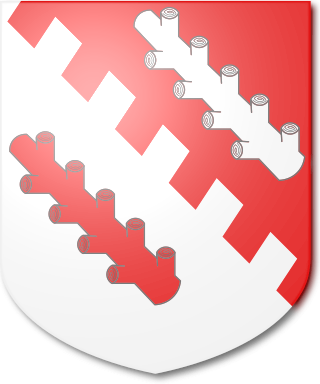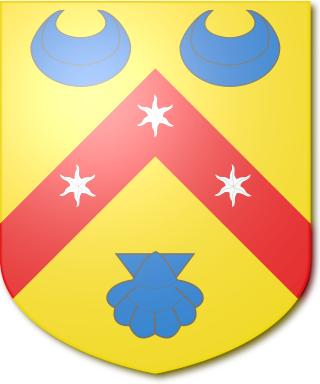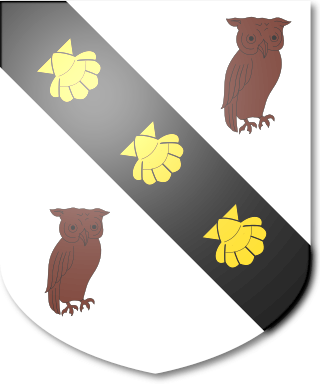
Viscount Hardinge, of Lahore and of Kings Newton in the County of Derby, is a title in the Peerage of the United Kingdom. It was created in 1846 for the soldier and Tory politician Sir Henry Hardinge. His son, the second Viscount, represented Downpatrick in Parliament. His great-great-grandson, the sixth Viscount, succeeded a distant relative as eighth Baronet, of Belle Isle in the County of Fermanagh, in 1986. This title had been created in the Baronetage of the United Kingdom 1801 for Richard Hardinge. He was the third son of Nicolas Hardinge, younger brother of Reverend Henry Hardinge and uncle of the latter's third son Henry Hardinge, 1st Viscount Hardinge. The baronetcy was created with special remainder to the heirs male of Richard Hardinge's father.

The Cumming-Gordon, later Gordon-Cumming Baronetcy, of Altyre near Forres, is a title in the Baronetage of the United Kingdom. It was created on 27 May 1804 for Alexander Cumming-Gordon, formerly member of parliament for Inverness Burghs. The Cumyn or Cumming family had been settled in Scotland since the 12th century. One member of the family, John II Comyn, Lord of Badenoch, married Eleanor, sister of King John of Scotland. Their son John III Comyn, Lord of Badenoch, known as the "Red Comyn", was a claimant to the Scottish throne through his mother. A later member of the family, Robert Cumming, 13th of Altyre, married Lucy, daughter of Sir Ludovic Gordon of Gordonstoun. Their great-grandson was the first Baronet, who assumed the additional surname of Gordon on succeeding to the Gordon of Gordonstoun estates. The second Baronet sat as Member of Parliament for Elgin Burghs. He changed the family surname from Cumming-Gordon to Gordon-Cumming. The fourth Baronet is best known as a central figure in the Royal Baccarat Scandal.

The Eliott Baronetcy, of Stobs in the County of Roxburgh, is a title in the Baronetage of Nova Scotia. It was created on 3 December 1666 for Gilbert Eliott. The second baronet was a member of the pre-union Parliament of Scotland. The third Baronet sat as Member of Parliament for Roxburghshire. The Eliott Baronets share a common early Elliot ancestry with the nearby Earls of Minto (Elliot). It is thought that the surname spelling differences were contrived to differentiate the branches.

The Boyle Baronetcy, of Ockham in the Parish of Salehurst in the County of Sussex, is a title in the Baronetage of the United Kingdom. It was created on 14 December 1904 for Edward Boyle, a barrister, businessman and Conservative Member of Parliament for Taunton. His grandson, the third Baronet, was also a Conservative Member of Parliament and ultimately cabinet minister serving as Minister of Education from 1962 to 1964. He was made a life peer as Baron Boyle of Handsworth, of Salehurst in the County of Sussex, in 1970 and became vice-chancellor of the University of Leeds in the same year. The life peerage became extinct on his death in 1981 and he was succeeded in the baronetcy by his younger brother, the fourth Baronet. As of 2023 the title is held by the latter's eldest son, the fifth Baronet, who succeeded in 1983.

The Henniker Baronetcy, of Newton Hall in the County of Essex, was created in the Baronetage of the United Kingdom on 2 November 1813 for Brydges Henniker, who had earlier represented Kildare Borough in the last Irish Parliament. He was the youngest son of John Henniker, 1st Baron Henniker. The sixth baronet was an admiral in the Royal Navy and sat as Conservative member of parliament for Galloway. The eighth Baronet was a brigadier in the Royal Engineers.
The Langham Baronetcy, of Cottesbrooke in the County of Northampton, is a title in the Baronetage of England. It was created on 7 June 1660 for John Langham, Member of Parliament for the City of London in 1654 and for Southwark in 1660 and 1661. The second Baronet was Member of Parliament for Northamptonshire and Northampton while the third Baronet sat for Northampton. The seventh Baronet was Member of Parliament for Northamptonshire. The tenth Baronet represented St Germans in the House of Commons. The thirteenth Baronet was a photographer, ornithologist and entomologist and served as High Sheriff of County Fermanagh in 1930.

The Mactaggart Baronetcy, of King's Park in the City of Glasgow, is a title in the Baronetage of the United Kingdom. It was created on 2 February 1938 for John Mactaggart. He was a housing expert and the co-founder of the building firm Mactaggart & Mickel. The second Baronet was managing director of Mactaggart & Mickel. The third Baronet was chairman of the Society for Individual Freedom.
There have been three baronetcies created for persons with the surname Primrose, two in the Baronetage of Nova Scotia and one in the Baronetage of the United Kingdom.

The Heaton, later Henniker-Heaton Baronetcy, of Mundarrah Towers in Sydney in Australia, is a title in the Baronetage of the United Kingdom. It was created on 31 January 1912 for the Conservative politician and postal reformer John Henniker Heaton. The second Baronet assumed the additional surname of Henniker.
There have been four baronetcies created for persons with the surname Bell, all in the Baronetage of the United Kingdom. One creation is extant as of 2007.

The Maclure Baronetcy, of The Home in Whalley Range near Manchester in the County Palatine of Lancaster, is a title in the Baronetage of the United Kingdom. It was created on 12 March 1898 for John William Maclure. He was Secretary of the Famine Relief Fund from 1862 to 1865 and sat as Conservative Member of Parliament for Stretford between 1886 and 1901.

The Elton Baronetcy, of Bristol, is a title in the Baronetage of Great Britain. It was created on 31 October 1717 for Abraham Elton, Mayor of and Member of Parliament for Bristol from 1722 to 1727. The second Baronet was also Mayor of Bristol and represented Taunton and Bristol (1727–1742) in the House of Commons. The seventh Baronet sat as Liberal Member of Parliament for Bath. The eighth Baronet was High Sheriff of Somerset in 1895. The tenth Baronet was a pioneer of the British documentary film industry.

The Smith, later Hamilton-Spencer-Smith, later Spencer-Smith Baronetcy, of Tring Park in the County of Hertford, is a title in the Baronetage of the United Kingdom. It was created on 11 June 1804 for Drummond Smith, with remainder to the heirs male of his niece Augusta, wife of Charles Smith, MP, of Suttons, Essex. The latter was a descendant of Robert Smith, of Ilminster, from whom the Smith-Marriott baronets are also descended. The fifth Baronet, was a member of the Military Inter-Allied Commission of Control from 1920 to 1924. The sixth Baronet discontinued the use of the surname of Hamilton.

The Huntington Baronetcy, of Clock House in the Metropolitan Borough of Chelsea, was a title in the Baronetage of the United Kingdom. It was created on 20 July 1906 for Charles Huntington, previously Liberal Member of Parliament for Darwen. The title became extinct on the death of the third Baronet in 1928.

The Stewart baronetcy, of Athenree in the County of Tyrone, was created in the Baronetage of the United Kingdom on 21 June 1803 for John Stewart. He was Attorney-General for Ireland from 1799 to 1803 and represented County Tyrone in the British House of Commons. The second Baronet also sat as Member of Parliament for County Tyrone. The sixth Baronet was Deputy Lieutenant of County Tyrone in 1971.
The Stewart Baronetcy, of Balgownie in Bearsden in the County of Dumbarton, was created in the Baronetage of the United Kingdom on 16 December 1920 for James Watson Stewart. He was a member of the Glasgow Corporation from 1904 to 1920 and Lord Provost of Glasgow from 1917 to 1920.
The Stewart Baronetcy, of Strathgarry in the County of Perth, was created in the Baronetage of the United Kingdom on 17 August 1960 for Kenneth Dugald Stewart. He was Chairman of the Trustee Savings Bank Association from 1946 to 1965. The third Baronet died in 2022 and as there were no living male descendants of the first Baronet, the baronetcy is extinct.

The Green baronetcy, of Wakefield in the County of York, and of Ken Hill in the parish of Snettisham in the County of Norfolk, was created in the Baronetage of the United Kingdom on 5 March 1886 for Edward Green, Conservative Member of Parliament for Wakefield. The second baronet became involved in the Royal Baccarat Scandal of 1890. The fourth Baronet was a deputy lieutenant and high sheriff of Norfolk and was a member of the Norfolk County Council.

The Russell baronetcy, of Swallowfield in the County of Berkshire, was created in the Baronetage of the United Kingdom on 10 December 1812 for Henry Russell. He was Chief Justice of Bengal and was admitted to the Privy Council in 1816. The 3rd Baronet represented Berkshire and Westminster in the House of Commons as a Conservative and was also awarded the Victoria Cross. The 4th Baronet sat as a Conservative Member of Parliament for East Berkshire. The 6th Baronet was a noted mineralogist.

The Kaye baronetcy, of Huddersfield in the County of York, was created in the Baronetage of the United Kingdom on 8 March 1923 for the textile manufacturer Joseph Kaye. He was a Senior Director of Kaye and Stewart Ltd, of Huddersfield, and a Director of the London, Midland and Scottish Railway and of Lloyds Bank.















